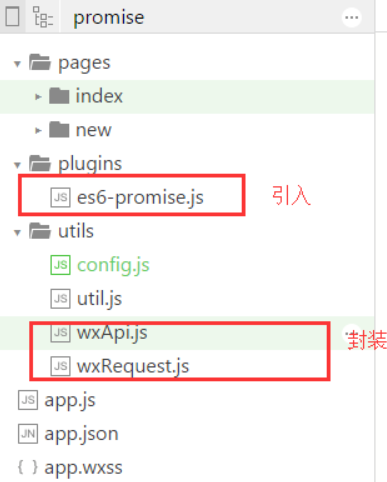如何用MD5加密微信小程序中的代码,安全问题大家都知道的,尤其是数据库之类的东西,比如做活动的时候。
下面介绍微信小程序如何加密——模块化
我们可以将一些公共的代码抽离成为一个单独的 js 文件,作为一个模块。模块只有通过 module.exports 或者 exports 才能对外暴露接口。需要注意的是:
(1)、 exports 是 module.exports 的一个引用,因此在模块里边随意更改 exports 的指向会造成未知的错误。所以我们更推荐开发者采用 module.exports 来暴露模块接口,除非你已经清晰知道这两者的关系。
(2)、小程序目前不支持直接引入 node_modules , 开发者需要使用到 node_modules 时候建议拷贝出相关的代码到小程序的目录中。
// common.js
function sayHello(name) {
console.log(`Hello ${name} !`)
}
function sayGoodbye(name) {
console.log(`Goodbye ${name} !`)
}
module.exports.sayHello = sayHello
exports.sayGoodbye = sayGoodbye在需要使用这些模块的文件中,使用 require(path) 将公共代码引入
var common = require('common.js')
Page({
helloMINA: function() {
common.sayHello('MINA')
},
goodbyeMINA: function() {
common.sayGoodbye('MINA')
}
})
仿照模块化方法我们可以加入MD5.js加密:
md5.js程序如下:
/*
* A JavaScript implementation of the RSA Data Security, Inc. MD5 Message
* Digest Algorithm, as defined in RFC 1321.
* Version 1.1 Copyright (C) Paul Johnston 1999 - 2002.
* Code also contributed by Greg Holt
* See http://pajhome.org.uk/site/legal.html for details.
*/
/*
* Add integers, wrapping at 2^32. This uses 16-bit operations internally
* to work around bugs in some JS interpreters.
*/
function safe_add(x, y)
{
var lsw = (x & 0xFFFF) + (y & 0xFFFF)
var msw = (x >> 16) + (y >> 16) + (lsw >> 16)
return (msw << 16) | (lsw & 0xFFFF)
}
/*
* Bitwise rotate a 32-bit number to the left.
*/
function rol(num, cnt)
{
return (num << cnt) | (num >>> (32 - cnt))
}
/*
* These functions implement the four basic operations the algorithm uses.
*/
function cmn(q, a, b, x, s, t)
{
return safe_add(rol(safe_add(safe_add(a, q), safe_add(x, t)), s), b)
}
function ff(a, b, c, d, x, s, t)
{
return cmn((b & c) | ((~b) & d), a, b, x, s, t)
}
function gg(a, b, c, d, x, s, t)
{
return cmn((b & d) | (c & (~d)), a, b, x, s, t)
}
function hh(a, b, c, d, x, s, t)
{
return cmn(b ^ c ^ d, a, b, x, s, t)
}
function ii(a, b, c, d, x, s, t)
{
return cmn(c ^ (b | (~d)), a, b, x, s, t)
}
/*
* Calculate the MD5 of an array of little-endian words, producing an array
* of little-endian words.
*/
function coreMD5(x)
{
var a = 1732584193
var b = -271733879
var c = -1732584194
var d = 271733878
for(var i = 0; i < x.length; i += 16)
{
var olda = a
var oldb = b
var oldc = c
var oldd = d
a = ff(a, b, c, d, x[i+ 0], 7 , -680876936)
d = ff(d, a, b, c, x[i+ 1], 12, -389564586)
c = ff(c, d, a, b, x[i+ 2], 17, 606105819)
b = ff(b, c, d, a, x[i+ 3], 22, -1044525330)
a = ff(a, b, c, d, x[i+ 4], 7 , -176418897)
d = ff(d, a, b, c, x[i+ 5], 12, 1200080426)
c = ff(c, d, a, b, x[i+ 6], 17, -1473231341)
b = ff(b, c, d, a, x[i+ 7], 22, -45705983)
a = ff(a, b, c, d, x[i+ 8], 7 , 1770035416)
d = ff(d, a, b, c, x[i+ 9], 12, -1958414417)
c = ff(c, d, a, b, x[i+10], 17, -42063)
b = ff(b, c, d, a, x[i+11], 22, -1990404162)
a = ff(a, b, c, d, x[i+12], 7 , 1804603682)
d = ff(d, a, b, c, x[i+13], 12, -40341101)
c = ff(c, d, a, b, x[i+14], 17, -1502002290)
b = ff(b, c, d, a, x[i+15], 22, 1236535329)
a = gg(a, b, c, d, x[i+ 1], 5 , -165796510)
d = gg(d, a, b, c, x[i+ 6], 9 , -1069501632)
c = gg(c, d, a, b, x[i+11], 14, 643717713)
b = gg(b, c, d, a, x[i+ 0], 20, -373897302)
a = gg(a, b, c, d, x[i+ 5], 5 , -701558691)
d = gg(d, a, b, c, x[i+10], 9 , 38016083)
c = gg(c, d, a, b, x[i+15], 14, -660478335)
b = gg(b, c, d, a, x[i+ 4], 20, -405537848)
a = gg(a, b, c, d, x[i+ 9], 5 , 568446438)
d = gg(d, a, b, c, x[i+14], 9 , -1019803690)
c = gg(c, d, a, b, x[i+ 3], 14, -187363961)
b = gg(b, c, d, a, x[i+ 8], 20, 1163531501)
a = gg(a, b, c, d, x[i+13], 5 , -1444681467)
d = gg(d, a, b, c, x[i+ 2], 9 , -51403784)
c = gg(c, d, a, b, x[i+ 7], 14, 1735328473)
b = gg(b, c, d, a, x[i+12], 20, -1926607734)
a = hh(a, b, c, d, x[i+ 5], 4 , -378558)
d = hh(d, a, b, c, x[i+ 8], 11, -2022574463)
c = hh(c, d, a, b, x[i+11], 16, 1839030562)
b = hh(b, c, d, a, x[i+14], 23, -35309556)
a = hh(a, b, c, d, x[i+ 1], 4 , -1530992060)
d = hh(d, a, b, c, x[i+ 4], 11, 1272893353)
c = hh(c, d, a, b, x[i+ 7], 16, -155497632)
b = hh(b, c, d, a, x[i+10], 23, -1094730640)
a = hh(a, b, c, d, x[i+13], 4 , 681279174)
d = hh(d, a, b, c, x[i+ 0], 11, -358537222)
c = hh(c, d, a, b, x[i+ 3], 16, -722521979)
b = hh(b, c, d, a, x[i+ 6], 23, 76029189)
a = hh(a, b, c, d, x[i+ 9], 4 , -640364487)
d = hh(d, a, b, c, x[i+12], 11, -421815835)
c = hh(c, d, a, b, x[i+15], 16, 530742520)
b = hh(b, c, d, a, x[i+ 2], 23, -995338651)
a = ii(a, b, c, d, x[i+ 0], 6 , -198630844)
d = ii(d, a, b, c, x[i+ 7], 10, 1126891415)
c = ii(c, d, a, b, x[i+14], 15, -1416354905)
b = ii(b, c, d, a, x[i+ 5], 21, -57434055)
a = ii(a, b, c, d, x[i+12], 6 , 1700485571)
d = ii(d, a, b, c, x[i+ 3], 10, -1894986606)
c = ii(c, d, a, b, x[i+10], 15, -1051523)
b = ii(b, c, d, a, x[i+ 1], 21, -2054922799)
a = ii(a, b, c, d, x[i+ 8], 6 , 1873313359)
d = ii(d, a, b, c, x[i+15], 10, -30611744)
c = ii(c, d, a, b, x[i+ 6], 15, -1560198380)
b = ii(b, c, d, a, x[i+13], 21, 1309151649)
a = ii(a, b, c, d, x[i+ 4], 6 , -145523070)
d = ii(d, a, b, c, x[i+11], 10, -1120210379)
c = ii(c, d, a, b, x[i+ 2], 15, 718787259)
b = ii(b, c, d, a, x[i+ 9], 21, -343485551)
a = safe_add(a, olda)
b = safe_add(b, oldb)
c = safe_add(c, oldc)
d = safe_add(d, oldd)
}
return [a, b, c, d]
}
/*
* Convert an array of little-endian words to a hex string.
*/
function binl2hex(binarray)
{
var hex_tab = "0123456789abcdef"
var str = ""
for(var i = 0; i < binarray.length * 4; i++)
{
str += hex_tab.charAt((binarray[i>>2] >> ((i%4)*8+4)) & 0xF) +
hex_tab.charAt((binarray[i>>2] >> ((i%4)*8)) & 0xF)
}
return str
}
/*
* Convert an array of little-endian words to a base64 encoded string.
*/
function binl2b64(binarray)
{
var tab = "ABCDEFGHIJKLMNOPQRSTUVWXYZabcdefghijklmnopqrstuvwxyz0123456789+/"
var str = ""
for(var i = 0; i < binarray.length * 32; i += 6)
{
str += tab.charAt(((binarray[i>>5] << (i%32)) & 0x3F) |
((binarray[i>>5+1] >> (32-i%32)) & 0x3F))
}
return str
}
/*
* Convert an 8-bit character string to a sequence of 16-word blocks, stored
* as an array, and append appropriate padding for MD4/5 calculation.
* If any of the characters are >255, the high byte is silently ignored.
*/
function str2binl(str)
{
var nblk = ((str.length + 8) >> 6) + 1 // number of 16-word blocks
var blks = new Array(nblk * 16)
for(var i = 0; i < nblk * 16; i++) blks[i] = 0
for(var i = 0; i < str.length; i++)
blks[i>>2] |= (str.charCodeAt(i) & 0xFF) << ((i%4) * 8)
blks[i>>2] |= 0x80 << ((i%4) * 8)
blks[nblk*16-2] = str.length * 8
return blks
}
/*
* Convert a wide-character string to a sequence of 16-word blocks, stored as
* an array, and append appropriate padding for MD4/5 calculation.
*/
function strw2binl(str)
{
var nblk = ((str.length + 4) >> 5) + 1 // number of 16-word blocks
var blks = new Array(nblk * 16)
for(var i = 0; i < nblk * 16; i++) blks[i] = 0
for(var i = 0; i < str.length; i++)
blks[i>>1] |= str.charCodeAt(i) << ((i%2) * 16)
blks[i>>1] |= 0x80 << ((i%2) * 16)
blks[nblk*16-2] = str.length * 16
return blks
}
/*
* External interface
*/
function hexMD5 (str) { return binl2hex(coreMD5( str2binl(str))) }
function hexMD5w(str) { return binl2hex(coreMD5(strw2binl(str))) }
function b64MD5 (str) { return binl2b64(coreMD5( str2binl(str))) }
function b64MD5w(str) { return binl2b64(coreMD5(strw2binl(str))) }
/* Backward compatibility */
function calcMD5(str) { return binl2hex(coreMD5( str2binl(str))) }
module.exports = {
hexMD5: hexMD5
}使用程序如下://index.js
var util = require('../../utils/md5.js')
//获取应用实例
var app = getApp()
Page({
data: {
page:'1',
},
var password=value.password;
if(password===""||password===null){
wx.showModal({
title:'提示',
content: '密码不能为空',
confirmColor:'#118EDE',
showCancel: false,
success: function (res) {
if (res.confirm) {
//console.log('用户点击确定')
}
}
});
return false;
}else{
password=util.hexMD5(password);
}
})utils目录
utils目录放的是我们工具脚本文件,我们在操作页面或者解析数据的时候常常需要写一些方法,通常是写在我们各自页面.js文件中或者是全局的app.js页面中,我们通常将一些复杂的逻辑代码抽取出来放在一个文件中封装成一个个函数,这样可以实现代码的模块化,也可以大量减少编写重复功能代码这类的工作。
把公共的方法封装起来,然后使用时需要先引入这个工具js文件,例如在系统给我们创建的小实例中,logs页面中的脚本文件logs.js需要引用utils目录下util.js中的formatTime()方法,使用前他需要使用var util = require('../../utils/util.js')引入util.js文件:
//logs.js
var util = require('../../utils/util.js')
Page({
data: {
logs: []
},
onLoad: function () {
this.setData({
logs: (wx.getStorageSync('logs') || []).map(function (log) {
return util.formatTime(new Date(log))
})
})
}
})引入之后直接使用
util.formatTime(new Date(log))来使用这个方法并传入参数即可。







网友评论文明上网理性发言 已有0人参与
发表评论: